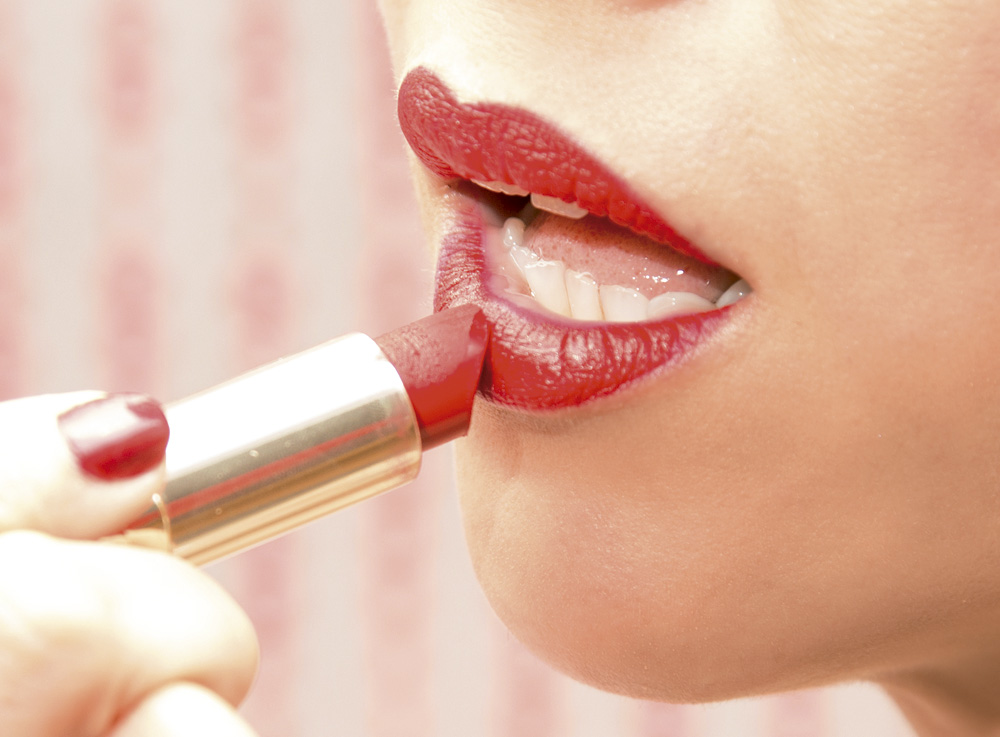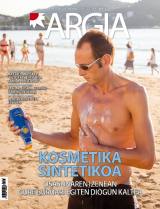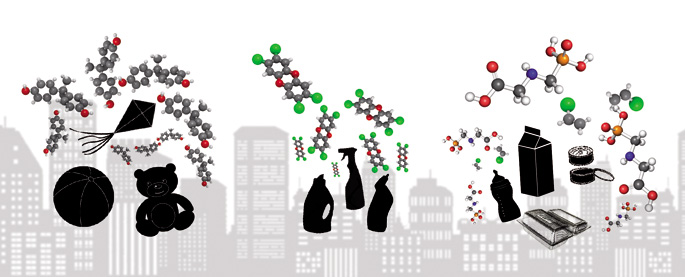If you cannot eat, do not give
- Very slowly, and even if it's only a part of the population, it seems that you're looking more at what goes into your mouth. We want to know where and how foods have been made, what ingredients we have introduced into the stairmago.Por the opposite, we do not know what we are entering the blood through the skin. We don't know what the moisturizer has, the consequences of painting the nails, what the shampoo has washed our hair and where it goes. There are many oil-based components, and many of them are on the list of potential health hazards.

“We are not the ecologists alone who are concerned about the health damage that cosmetic products can cause, scientists are also saying that we need to be attentive to hormonal contaminants. In the Spanish state there are some of the best researchers in the world who study hormonal contaminants. Call the University of Granada.” Kistiñe García is a member of Ekologistak Martxan and manages the web on hormonal contaminants www.libresdecontaminanteshormonales.org. As a pesticide, it's dedicated to cosmetics.
We've called Mariana Fernández, a PhD in Chemical Sciences and a researcher at the Biomedicine Center of the University of Granada, to ask her if we're not risking health by manipulating cosmetic products, by painting nails, by steaming, by moisturizing the skin, by taking care of ourselves and beautifying ourselves. Fernandez believes that some of the chemical components used in cosmetics are very worrying, as they can affect the hormonal system, as they are hormonal contaminants. Researchers have linked these components to the following risks: reproductive and developmental problems, metabolic diseases (obesity, diabetes), immune and neurological system problems, thyroid problems, and cancer. The scientist talks about the relationship between oil-based components and health risks, as it is difficult to prove that hormonal contaminants have caused some damage. It is difficult to prove, and also damage occurs for many years, up to 20 years before the consequences appear. Sometimes, damage occurs in the offspring of those who have internalized hormonal contaminants, and not in those who have used them.
We live under the influence of a group of synthetic products (far beyond cosmetics) and Fernández believes that their toxic characteristics are not well known and have not been investigated. Not knowing does not mean that they are not harmful. The other thing is that the scientist thinks the attitude is naive, thinking that each chemical component is going to affect us separately. To analyse the effects of chemical components on each other. This is what they call cocktail influence. It therefore considers that measuring the risk of individual chemical components is unintentional and naïve.

How to choose a safe moisturizer?
Fernandez has given us the following example. The European Chemicals Agency has decided to include Bisphenol A in the list of “very worrying components”. It has been a difficult decision and has had to carry out numerous scientific work to demonstrate the relationship between this component and health problems. Take this specification into account, they have put it on the list of “very worrying ingredients” for the human being, they have not banned it. It is therefore up to the manufacturer to continue using the component, limit its use or stop using it.
It is very difficult to demonstrate the harmful effect that synthetic components have on our body, often the consequences appear over several years, when they are considered dangerous they are put on a “black list” and the decision is left to the manufacturer... With such uncertainty, how will the consumer choose to paint lips that do not harm his health? Why are you going to buy the moisturizer that's on the top shelf and not the bottom shelf? We've asked Kistiñe García if we have to read and analyze the full list of shampoo ingredients to decide whether we buy it or not, and of course, if we have to do a course to know the ingredients: “I can’t advise that, we can’t walk like that, sometimes the lists are very long and it takes a magnifying glass to read. And another thing is to bear in mind that it is not possible to avoid all the health consequences arising from synthetic products. You asked me about cosmetics, but we live surrounded by synthetic ingredients, there are pesticides and plastics. Let me give you an example: you can make a big effort in looking for a moisturizer that doesn’t have synthetic ingredients and your plastic packaging may have hormonal contaminants.”
Focus on the first 4-5 ingredients of the products. Among them, about 90% of the product ingredients are concentrated
In 2015, the University of Berkeley and the Salinas Valley Health Clinic conducted research with female adolescents in the United States. It was found that on average 17 cosmetics were used a day and as a teenager his hormonal system was developing, making them more vulnerable to hormonal contaminants. The usual cosmetics were removed for three days and those without parabens or phthalates were forced to use. Urine analysis showed that methyl and propyl parabens decreased 44% and 45%, diethyl phthalate metabolites decreased 27% and triclosan and benzophenone metabolites decreased 36%.
Garcia, a member of Ekologistak Martxan, has recommended that we do not go crazy in the election and has given us instructions to buy the most natural and safe cosmetics we can. Focus on the first 4-5 ingredients of the products. Among them is approximately 90% of the ingredients of the product. In the early stages, the more synthetic ingredients, the greater risk and uncertainty we have, the more organic ingredients we have in the podium, the safer the product is. There are mobile phone applications for reading and analyzing product components (see ThinkDirty and Ingred apps in the box). We can do these kinds of exercises by approaching the shelves of any trade. Still, according to García, we have more options to buy safer products in natural cosmetics stores, such as grass shops. In any case, García has recommended that we make as many cosmetics as possible at home, because it is the safest and cheapest, although we have little experience in the elaboration of various products (makeup, deodorant...). Garcia has stressed that in recent years people have started to make home moisturizers, to protect lips and soaps. Very similar products can be purchased in the store, but do not go out at such a good price.

What if we used what we did at home?
Garbiñe Larrea is a naturopath (in the federation of naturopathies FENACO, with number 4131) and specialist in herbs and natural cosmetics. We asked him if his client is people concerned about the risks of synthetic cosmetics. More than people with conscience, he tells us he has a client with health problems. Many have skin problems, from the child to cancer. He tells us a few examples. A mother confessed to him that he was passionate about hygiene and that the children were well provided with gel, shampoo, colony and cream. The children had skin problems. He asked his father to do a simple test: remove all the products he used and use one or the other he recommended. The skin problems disappeared. It recommends testing pastures, avoiding synthetic cosmetics and experimenting with those produced with natural ingredients, as it has observed that in some superficial problems the situation changes from black to white.
She teaches natural cosmetic courses and many students ask her to do cosmetics and sell. It does not intend to open the store, it does not want to sell it, it wants to do what it has seen at home in today's houses, that is to say, to make oneself soaps, ointments, etc. : “The soap we were doing at home among family members, I learned to make creams at the age of 8. Now people are willing to buy natural products, but I'm betting on personal adaptation. I want you to learn as many people as possible. Collect and make cosmetics in free time. Some tell us that we are hippies, but it’s simply to repeat what our elders have done.” This avoids the risks of synthetic cosmetics, which are much cheaper at home than the store’s natural cosmetics.
Two expressions of the grassland have remained in memory: “We’re paying for the use of synthetic cosmetics” and “if you can’t eat, don’t do it.”
How to Choose a Solar Cream Without Hormonal Contaminants
The risk of the greatest damage from hormonal contaminants is that of pregnant women and children. In the case of sunscreen, the components (toxic or not) pass from the skin to the body and in the case of the pregnant woman accumulate in the placenta and in the uterus. A study carried out at the Barcelona hospital in Sant Joan de Déu revealed that pregnant women presented 500 times more toxic than expected. The newborn may have developmental problems or may have consequences (sterility or cancer) many years later. Like pregnant women, it is children who are exposed to risks. The child grows and hormones are of great importance.
In the market, there are more and more solar creams that are safer and healthier. Marketers have realized that shoppers are worried and that they are choosing products more carefully. In Denmark, the Think Chemical Consumer Council analyzed 66 solar creams and 40% had no pollutants hormonales.La complete list is on the net. Although most are sold only international brands in Denmark. In the Enviromental Working Group database, 750 solar creams have been analysed and classified according to their degree of toxicity.

On the websites or conversations that warn us of the risks of hormonal contaminants, the basic advice for the sun is to look for the shade to be possible or avoid exposure to the sun during the middle hours. What options does anyone want to do the opposite to avoid solar creams with oil-based components? In natural cosmetics, there are two ways to put a filter in the sun. On the one hand there are the biological filters, the oils of karite germs, raspberries and wheat. However, they do not have the same level of protection as conventional creams and are of short duration. On the other hand, there are physical filters. Zinc oxide, mica and titanium dioxide are commonly used. However, the International Agency for Research on Cancer (IARC) has included the latter in the list of potential cancer generators.
The cosmetic industry knows that the purchaser will not start reading the list of small-letter ingredients of each solar cream pot. There is often a need for magnifying glass and a great deal of knowledge about toxic and non-toxic components. Organizations warning of the risks of hormonal contaminants recommend the search for labeled products that indicate that cosmetics are eco-friendly. The seller who has used one of these labels has taken the job of getting the label for their products.
Although we have said that we will not learn from memory the dangerous components, the most common ones and that it is appropriate to avoid in case they are:
- Benzophenone 3 and 4 (BP-3 and BP-4)
- Camphor 4-methylbenzilidene (4MBC).
- Ethyl exil methoxyzinamate (is a physical filter but related to health problems) .
- Methyl paraben and ethyl paraben
phthalates (DEP, DINP, DEHP…).
- Butylhydroxytoluene (BHT), scents, synthetic mosquettes, mineral oils.
Organic, natural, ecological… Yeah, sure?
The survey was conducted by the Soil Association of the United Kingdom. He asked consumers what they associated with the words “natural”, “ecological” or “organic” in cosmetics. A total of 76 per cent of the participants were of the opinion that the products showing these words had an ecological certificate issued by an independent association. Consumers believed that non-toxic products were being bought and were being used for this.
Of the thirteen products analyzed, nine were more expensive than organic substitutes. In other words, they were said to be “green” and sold the most expensive product.
69% of the participants in the concentration were of the opinion that the use of such words is illegal. However, it is not illegal because, although in small quantities, these products contain some ecological component. Furthermore, the use of these words is not regulated.
The British association found toxic components in these products, declared the Ten Fears, which have been withdrawn from the United Kingdom. In other words, these ingredients would never get the eco-certificate. Here are three examples of the Ten Temibles:
- The product of the brand Aloe Pura uses the expression “Organic Aloe Vera”. Unlike natural retinol, it contains an artificial retinol palmitate, a type of vitamin A. It is advised not to use it during pregnancy, as it may exceed the daily dose of vitamin A and cause fetal malformations. It can also cause pollution in the environment.
- “Organic suncare” (solar organic) says, but in the product three components of the list of ten fears have been found: octinoxate, homosalate and octisalate.
- The room of the Rituals brand indicates that it contains argan and organic eucalyptus oils. It's not a lie if you have it, but the buyer can understand that the whole product is organic. The problem is that in 28 components oils are 11th and 12th, that is, the top ten components are in greater quantity.
72% of the participants said that if they knew that any brand used that “false verdor”, they would lose their confidence in this house.
The Soil Association has the following terrifying elements:
- imidazolidinil urea
-
octokrilene - PEG-7; PEG-12; PEG-40;
PEG-200) -
polyquaternium-7 - polysorbate 20
- artificial red
17-26100
- octinoxate
- octisalate
- retinol palmitate
Produktuen osagaiak irakurtzen laguntzeko aplikazioak sortzen ari dira herritarrak. Hona bi adibide:
Think Dirty: Lily Tseren etxean bularreko minbizia izan zuten. Horren ondorioz kosmetikoetan eta higieneko produktuetan osagai toxikoak aztertzea erabaki zuen. Osagai batzuen arriskuak ezagututa, seguruagoak zirenen bila hasi zen, baina oso zaila egiten zitzaion bilaketa. Azkenean, sakelako telefonorako prestatutako aplikazio bat sortu zuen produktuen barra kodeak irakurri eta haien informazioa emateko. 2013an sortu zuen eta ia 68.000 produktu inguru begiratu daitezke.
Ingred: Raul Vadillo ingeniari informatikoak sortu zuen aplikazioa. Haren emazteak kosmetika segurua eta elikagai osasungarriak bilatzen zituen eta nekagarria egiten zitzaion paperean zuen osagai arriskutsuen zerrendarekin batera eta bestera ibiltzea. Hala, Ingred sortu zuen, produktuen osagaiei argazkia atera eta aplikazioak haien arriskuaren araberako mailaketa egiten du. Zuzenean osagai baten izena ere idatz daiteke.
Estrasburgon egindako saioan, Eurolegebiltzarrak ezetz esan dio kutsatzaile hormonalak definitzeko Europako Batzordeak –saiakera askoren ostean– aurkeztutako irizpide sortari. Batzordearen testuak zientzialari ugariren kritikak jaso ditu, hala nola Europa osoko... [+]
Irailaren 25etik 28ra egingo da, Bilboko Mediku Zientzia Akademiak antolatuta, Medikuntza Astearen 44. edizioa. Aurtengo goiburua Osasuna eta kutsadura: Epidemia isila da. Lehenbiziko hizlaria Nicolás Olea Granadako Unibertsitateko medikuntza katedraduna eta disrupzio... [+]
Hainbat urteko atzerapenez, eta Europako Batzordeak proposamenaren zirriborroa maiz aldatu eta gero, kutsatzaile hormonalak identifikatzeko irizpideak onartu dituzte EBko estatu kideek. Talde ekologistek eta zenbait zientzialari elkartek kritikatu dute araudiak ez dituela behar... [+]
Europako Legebiltzarrak eskatu du elikagaiak gordetzeko ontzi guztietan A bisfenol izeneko konposatua debeka dadila. Era berean, elikagaien ontziratzean erabiltzen diren substantzia kimikoak zorrotzago arautzea galdatu dute europarlamentariek.
Ekologistak Martxan elkarteak jakinarazi du Espainiako Estatuan herritarrek kontsumitzen dituzten fruitu eta barazkiek beren mamian daramatzatela gutxienez 33 disruptore endokrino, gizakiei gaixotasun larriak eragiten dituztenak. Hamar elikagai kutsatuenen taula ikusgarria ere... [+]


















